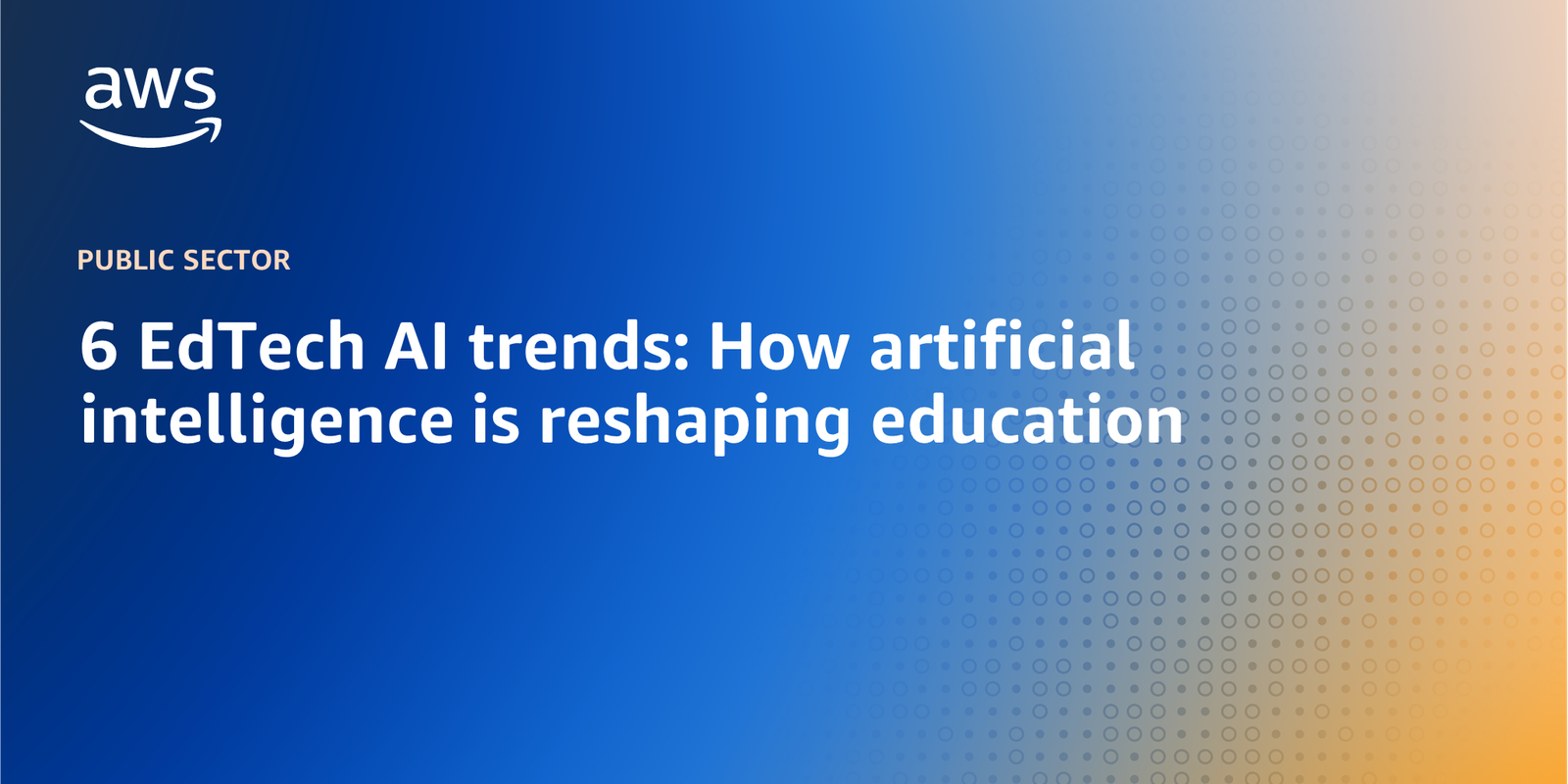Education
6 EdTech AI trends: How artificial intelligence is reshaping education

Innovation has always driven education technology (EdTech), and in 2025, artificial intelligence (AI) is leading the next wave. No longer just an emerging tool, AI is becoming the fundamental infrastructure shaping how EdTech evolves—reshaping how EdTechs develop solutions, how educators teach, and how students learn. It’s no longer a question of whether AI has a place in education, but how deeply embedded it will become.
At Amazon Web Services (AWS), we work with EdTechs of all sizes, giving us unique insight into how AI is shaping the industry. Based on our work with EdTechs and educational institutions around the world, we’ve identified six key trends shaping the future of AI in education.
1. AI is evolving from a tool to core infrastructure
A major shift is underway: AI is moving from being an add-on to an essential layer of EdTech infrastructure. AI is no longer just a feature; it is becoming the backbone of both EdTech products and internal operations.
EdTechs are embedding AI directly into their platforms to enhance learning experiences at scale. Instead of one-size-fits-all content, AI-driven solutions can analyze student assessments and dynamically tailor lesson plans to individual needs. This shift makes education more personalized, efficient, and effective.
At the same time, AI is optimizing how EdTechs operate. Companies are using AI to streamline business functions, from sales and marketing functions like forecasting, email marketing, and upselling, to finance, human resources (HR), and customer support. By automating routine tasks and surfacing actionable insights, AI allows teams to focus on product innovation and improving the customer experience.
The big takeaway for EdTechs? AI is no longer an option—it’s a necessity for staying competitive.
2. Educational institutions are adopting AI faster than expected
Historically, education has been cautious about adopting new technology. AI is proving to be the exception. Schools, colleges, and universities are integrating AI-powered solutions at an unprecedented pace. In a 2024 Ellucian survey of 445 faculty and administrators from across the US and Canada, 93 percent expect to expand their use of AI in their work over the next two years.
Unlike previous technologies that required extensive retraining, today’s AI tools integrate seamlessly into the workflows educators and students already use. Plus, as AI demonstrates immediate results and educators see real efficiency gains, this has led to higher comfort levels and faster adoption across institutions.
Trust has been another key factor in AI adoption among educators and institutions. EdTechs placed an early emphasis on responsible AI development, involving education institutions in shaping AI tools from the beginning to align with ethical standards, data privacy, and real-world classroom needs. This collaborative approach helped educators feel more comfortable with AI and accelerated adoption beyond what we’ve seen with previous technologies.
At the same time, alternative learning pathways like microcredentials and skills-based courses—such as those offered by Coursera and other platforms—are seeing rapid growth, particularly in AI and machine learning. In fact, 40 percent of Coursera’s top courses in 2024 teach AI, with three million new enrollments in generative AI courses during the year—one every 10 seconds. These programs highlight both the demand for accessible, flexible learning and the speed at which AI-related knowledge is being disseminated outside of traditional institutions.
3. AI is shifting from reactive to proactive support
One of the most significant changes we’re seeing is AI moving from reactive to proactive support models. Early AI systems waited for users to ask questions. In 2025, AI systems can understand context, anticipate needs, and offer support before anyone asks.
This shift makes truly personalized support possible at scale. For students, AI can now analyze assessment results and create customized learning paths targeting specific knowledge gaps. For example, Curriculum Associates uses AI on AWS to offer assessment programs that analyze results and deliver tailored content based on each student’s individual needs.
This evolution complements a broader shift in education platforms, moving from content-library models to more collaborative, student-centric environments. Modern learning management systems (LMS) like Schoology, Moodle, and Canvas increasingly support personalization, collaboration, and analytics. When combined with AI, these platforms can become even more adaptive and responsive to students’ learning preferences and progress.
For educators, AI is transforming administrative work. Benchmark Education’s AI-powered grading tool helps evaluate open-ended assessments, giving teachers valuable time to focus more on one-on-one instruction and student engagement.
With the development of AI agents, we are see more automation in education systems—where AI not only recommends but executes next steps, such as dynamically adjusting lesson plans or proactively suggesting interventions for struggling students before an educator even notices a gap.
4. Addressing education equity in an AI-powered world
AI has the power to transform education—but only if students have access to it. According to the Pew Research Center, internet access in the US has increased from 85 percent to 96 percent in the past decade. However, global access remains considerably lower. If AI-powered learning tools create superior educational experiences yet remain inaccessible to underserved communities, existing educational inequalities could widen.
Public-private partnerships will play a critical role in addressing this challenge. AWS is actively working with nonprofit consortiums and governments to extend AI-powered tools to all students. For example, Amazon’s Project Kuiper aims to provide satellite-enabled internet access worldwide and has the potential to expand connectivity to underserved regions and remote areas, helping students gain access to the same high-quality materials as more connected regions.
Additionally, the AWS Education Equity Initiative, announced last December, is investing $100 million to support technologies, specifically designed for underserved students and markets globally. For EdTechs seeking to develop solutions for underrepresented communities, learn more about how to apply for the AWS Education Equity Initiative here.
5. Real solutions will attract investment
Venture capital investment in EdTech has declined since 2021, but that doesn’t mean funding has disappeared. Instead, investors are focusing on companies that solve real, measurable problems.
The era of building AI solutions simply for the sake of AI is over. Institutions are under pressure to demonstrate ROI, meaning they are prioritizing EdTech solutions that deliver measurable learning outcomes, time, and cost savings for educators, and improved student engagement and retention. EdTech startups should focus on niche solutions with clearly defined value propositions rather than attempting to build broad, one-size-fits-all platforms.
One example? Transportation challenges in education. I recently read that in Baltimore, about 25,000 students rely on public transit to get to school because the city doesn’t provide buses after fifth grade—leading to chronic tardiness and lost learning time. AI-powered solutions integrating route optimization with real-time traffic analytics to automatically adjust class schedules is one such possibility for these scenarios. Solving challenges like this requires both public policy and technology innovation to reduce costs and increase scalability, but it’s a prime example of the kind of impact-driven disruption investors are looking for.
6. AI could redefine learning itself
Beyond improving existing education models, the proliferation of AI is pushing us to ask: What could the future of learning look like? Just as the calculator transformed how students learn mathematics, and the internet transformed study and research, AI will force us to rethink learning. As the traditional education model of rote memorization and recall is made obsolete by on-demand information, moving forward, education models could prioritize critical thinking and creativity as core competencies, with personalized learning to match individual learning styles and career goals. AI also provides opportunities to lean into Generation Z and Generation Alpha’s preference for visual learning, instant feedback, and digital collaboration, making education more relevant and effective for modern learners.
AI won’t replace teachers, but it could redefine their roles. Educators could shift from content delivery to learning facilitators, helping students develop higher-order skills that AI cannot replicate. By 2030, we may even see new education models emerge, where AI-driven personalization and predictive analysis make traditional one-size-fits-all curriculums obsolete, while learners have an omnipresent AI tutor or coach supporting the learning journey. The challenge, then, is ensuring that innovation aligns with real-world needs and career pathways, so students graduate prepared for a world where AI is everywhere.
Looking ahead: What’s next for EdTech?
As we move through 2025, AI will continue transforming education in ways both expected and unexpected. For EdTechs navigating these changes, focusing on real problems with measurable outcomes remains the surest path to success.
At AWS, we’re committed to supporting EdTechs throughout this journey. Our dedicated EdTech vertical team provides comprehensive assistance, from technical solution development to go-to-market support, helping companies leverage the AWS Cloud to build the next generation of educational technologies.
Want to explore how AI can transform your EdTech solutions? Connect with an AWS EdTech expert today.
Read related stories on the AWS Public Sector Blog:
Education
Ram Chella – Colleges Of The Future: AI Transforming Education And Employability

Q. How do you see the shift in approach in higher education with AI becoming an integral part of the workspace and learning?
Education in India is standing at an inflection point. For decades, colleges have measured success by degrees awarded, not by the employability of their graduates. But in the age of artificial intelligence (AI), that equation is being rewritten.
The next generation of top 100 colleges to watch will not be the ones that fear AI. They will be the ones that integrate AI elegantly into their workflow—enhancing learning, improving knowledge retention, and producing students with ‘Proof of Readiness’ rather than just certificates.
Traditional classrooms focus on theory. Employers, however, demand proof. The new model of education flips the script: students are trained and assessed in AI-powered practice environments that validate not just what they know, but how ready they are to perform.
From ‘Degrees to Data-Backed Readiness,’ this shift has far-reaching impact. For students it means higher retention, greater confidence, and stronger employability; for colleges it is a decisive move from degree-centric to outcome-centric reputations; for India it is the ability to uplift 100 million learners at scale, fueling national competitiveness.
Q. Could you share a few examples as ‘a case in point’ that are becoming ‘Colleges of the Future’?
Across India, pioneering initiatives are breaking away from the monotone of certificates and resumes. They are proving that employability in the AI era means readiness, not paperwork:
-
AICTE (All India Council for Technical Education) is redefining how education meets industry. Instead of only accrediting degrees, AICTE is actively integrating AI to match students with industry needs—focusing on skills, outcomes, and readiness rather than just certificates.
-
SWAYAM Plus is shifting from being a digital catalogue of courses to becoming an AI-enabled readiness platform, where learners don’t just “complete” modules but demonstrate skills mapped to real employer demand.
-
Apna Jobs has already powered 7 lakh+ interviews through AI-driven skill-matching, eliminating the inefficiency of resumes. By using AI to perform the “non-scalable” tasks—connecting people with the right opportunities at scale—Apna is showing how technology can redefine placements.
These aren’t just incremental improvements. They represent a systemic break from the past—moving India’s education ecosystem from certificates and resumes to data-backed readiness and employability.
Q. Given the urgency of ‘now,’ why does AI-integrated learning matter beyond campuses?
The push for transformation is not just coming from students or regulators. It is being demanded by employers who are struggling to find talent that is not only qualified on paper but genuinely ready to perform on ‘Day One.’ Hiring managers across IT, BFSI, and manufacturing echo the same frustration: traditional degrees tell them what a student has studied, but not whether that student can actually deliver results.
AI-powered readiness models solve this gap. By validating practice, fluency, and applied skills, they give companies the confidence to hire faster and at scale. It isn’t just good for employers—it’s essential for India’s competitiveness.
Consider the numbers: India produces nearly 1 crore graduates every year, yet industry studies show that less than 30% are considered employable. Closing this gap is not an academic issue; it is an economic emergency. If even 10% more graduates enter the workforce job-ready, the productivity impact could add billions to India’s GDP annually.
This is why the ‘Colleges of the Future’ are not waiting. They are breaking free from the monotone of certificates and resumes, proving that readiness is the new currency of employability.
Q. What is the big picture in your opinion?
The overarching scenario is that it is not about survival. This is about transformation at scale. The future of India’s workforce depends on how boldly higher education institutions embrace AI—not as a threat, but as a partner. In fact, the foundation should start at the school level.
And as we celebrate these Colleges of the Future, we set the stage for a new era where education does not end with a certificate. It ends with readiness for the world of work.
Education
Best UK universities for education – league table

The study of how people develop and learn – including education studies, undergraduate teacher training and academic studies in education
Education
Guardian University Guide 2026: find your subject | University guide

Accounting and finance
The league table
What the subject is about
Aerospace engineering
The league table
What the subject is about
Anatomy and physiology
The league table
What the subject is about
Animal science and agriculture
The league table
What the subject is about
Animation and game design
The league table
What the subject is about
Anthropology and archaeology
The league table
What the subject is about
Architecture
The league table
What the subject is about
Biology
The league table
What the subject is about
Biomedical science
The league table
What the subject is about
Business and management
The league table
What the subject is about
Chemistry
The league table
What the subject is about
Classics and ancient history
The league table
What the subject is about
Computer science and information systems
The league table
What the subject is about
Construction, surveying and planning
The league table
What the subject is about
Creative writing
The league table
What the subject is about
Criminology
The league table
What the subject is about
Dentistry
The league table
What the subject is about
Drama and dance
The league table
What the subject is about
Earth and marine sciences
The league table
What the subject is about
Economics
The league table
What the subject is about
Education
The league table
What the subject is about
Engineering: chemical
The league table
What the subject is about
Engineering: civil
The league table
What the subject is about
Engineering: electrical and electronic
The league table
What the subject is about
Engineering: general
The league table
What the subject is about
Engineering: mechanical
The league table
What the subject is about
English
The league table
What the subject is about
Fashion and textiles
The league table
What the subject is about
Film production and photography
The league table
What the subject is about
Fine art
The league table
What the subject is about
Forensic science
The league table
What the subject is about
Geography
The league table
What the subject is about
Graphic design
The league table
What the subject is about
Health professions
The league table
What the subject is about
History
The league table
What the subject is about
History of art
The league table
What the subject is about
Hospitality, event management and tourism
The league table
What the subject is about
Interior design
The league table
What the subject is about
International relations
The league table
What the subject is about
Journalism
The league table
What the subject is about
Languages and linguistics
The league table
What the subject is about
Law
The league table
What the subject is about
Marketing and public relations
The league table
What the subject is about
Mathematics
The league table
What the subject is about
Media and film studies
The league table
What the subject is about
Medicine
The league table
What the subject is about
Midwifery
The league table
What the subject is about
Music
The league table
What the subject is about
Nursing: children’s
The league table
What the subject is about
Nursing: general
The league table
What the subject is about
Nursing: mental health
The league table
What the subject is about
Nutrition and food science
The league table
What the subject is about
Paramedic science
The league table
What the subject is about
Pharmacy and pharmacology
The league table
What the subject is about
Philosophy
The league table
What the subject is about
Physics
The league table
What the subject is about
Physiotherapy
The league table
What the subject is about
Politics
The league table
What the subject is about
Product design
The league table
What the subject is about
Psychology
The league table
What the subject is about
Social work
The league table
What the subject is about
Sociology and social policy
The league table
What the subject is about
Sports science
The league table
What the subject is about
Theology and religious studies
The league table
What the subject is about
Veterinary science
The league table
What the subject is about
-

 Business2 weeks ago
Business2 weeks agoThe Guardian view on Trump and the Fed: independence is no substitute for accountability | Editorial
-
Tools & Platforms1 month ago
Building Trust in Military AI Starts with Opening the Black Box – War on the Rocks
-

 Ethics & Policy2 months ago
Ethics & Policy2 months agoSDAIA Supports Saudi Arabia’s Leadership in Shaping Global AI Ethics, Policy, and Research – وكالة الأنباء السعودية
-

 Events & Conferences4 months ago
Events & Conferences4 months agoJourney to 1000 models: Scaling Instagram’s recommendation system
-

 Jobs & Careers2 months ago
Jobs & Careers2 months agoMumbai-based Perplexity Alternative Has 60k+ Users Without Funding
-

 Podcasts & Talks2 months ago
Podcasts & Talks2 months agoHappy 4th of July! 🎆 Made with Veo 3 in Gemini
-

 Education2 months ago
Education2 months agoMacron says UK and France have duty to tackle illegal migration ‘with humanity, solidarity and firmness’ – UK politics live | Politics
-

 Education2 months ago
Education2 months agoVEX Robotics launches AI-powered classroom robotics system
-

 Podcasts & Talks2 months ago
Podcasts & Talks2 months agoOpenAI 🤝 @teamganassi
-

 Funding & Business2 months ago
Funding & Business2 months agoKayak and Expedia race to build AI travel agents that turn social posts into itineraries

